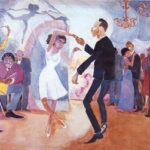The Harlem Renaissance remains one of the most significant artistic movements in American history, far surpassing its original importance to one specific minority. The renaissance served to create a consciousness of identity for African-Americans, while also forcing white American to confront the importance of an ethnic group too long considered inferior. The Harlem Renaissance is best remembered today as an explosion of creativity bursting from the talented minds of African-Americans in the 1920s, although in reality it was the locus for the radicalization and politicization of a disenfranchised populace as much as it was an artistic movement. Although generally considered an African-American literary movement, the Harlem Renaissance extended far beyond books and poetry to embrace art, dance, and music. The creative minds behind the Harlem Renaissance used artistic expression to make a significant impact on all aspects of society, while also endowing African-American with their first sense of identity not defined by slavery.
During the early 20th century, three-quarters of a million African-Americans escaped the economic depravation of the South and migrated northward to urban cities in a desperate attempt to find good jobs and economic security and also searching for a more racially tolerant society. 175,000 of these African-Americans settled in New York City (Wintz 15). To attach a stark beginning to the Harlem Renaissance by singling out one particular text is an exercise in futility and bound to spur debate. Black writers had been published since the 19th century, but the differentiation that makes the Harlem Renaissance easily definable as a turning point was the breadth of topics that black writers covered. The true origins of the Renaissance lay not in any single work that ignited a revolution, but in the various and multiple congregations of shared interests by those desiring to propagate the stunning burst of creativity through the publication of literary magazines and books. This collective urge to help one another was a primal element in turning the movement from a purely literary one into one that embraced all the fine arts; it was also integral in turning the Harlem Renaissance into a search for a new identity for an ethnic group previously defined by the centuries of slavery. Although the artists created vital and lasting works of literature, art and music, the Harlem Renaissance quickly became just as important for the way in which is gave African-Americans a real culture and a pride in acknowledging and embracing that culture. Prior to this era, the representations of African-Americans in American literature were that of the illiterate and inferior peasant who made his living in the dirt of the cotton fields. The intellectuals contributed to the significance of the Harlem Renaissance by understanding and contributing to its purpose in defining positive role models for blacks. One of the immensely important traits of the Harlem Renaissance is that cooperation was considered a better way to facilitate even the individual works than competition. An intuitive sense that any single artistic endeavor was going to define all others created an effort by everyone involved to create a cultural tapestry that served not just other artists, but audiences as well. In fact, the movement essentially created the idea of the black intellectual for both Americans and Europeans. The creation of the “New Negro” in Harlem represented the liberation of the last vestiges of slavery, those of low esteem and even self-doubt and self-revulsion (Kramer and Russ 134-136).
Critics, however, question whether the Harlem Renaissance really achieved its aims of forging a new identity for blacks separated from the history of slavery. One of the criticisms is that by trying to create distinct culture separated from the past abuses and even the contribution of Anglo-European traditions it succeeded only in alienation. A more potent criticism is that the Harlem Renaissance reproduced only the specific identity of the middle class, intellectual elite of an ethnic group trying to impress its background and views on a population still dominated by lower-class and uneducated people. Still another criticism is that the very goal of forging an identity for an entire ethnic group and socially edifying them was grossly ill-conceived because the overwhelming number of African-Americans are mostly unaware of it or know it only as history at best (Kramer and Russ 51). The foundation of all criticism of the Harlem Renaissance is that it contains an inescapable element of hypocrisy in that it attempted to create a separate identity that was based mostly on the bourgeois ideology inculcated by its intellectual and artistic leaders from a white society and educational system. What can be extrapolated from the criticism is that it sought to achieve little more than a black representation of the white middle class establishment.
What is not up for argument is the actual value of the artistic contributions of the era. James Weldon Johnson is an iconic figure in the initiation of the Harlem Renaissance both as writer and editor. He had written the controversial Autobiography of an Ex-colored Man in and had also edited The Book of American Negro Poetry. This collection showcased several of the Renaissance’s most talented poets, including a man who would go on to become a giant in the literary world, Langston Hughes. Hughes possessed a passion for music and served as a conduit for exposing the value of traditional black folk music (Helbling 100-103). Zora Neale Hurston published a literary magazine that folded almost immediately because of problems raising money, but was influential nonetheless. Hurston later achieved immortality with her book Their Eyes were Watching God.
Literature was not the only art that defined the Harlem Renaissance, however. In fact, the music of the era may have been more influential in defining the identity of the common African-American than the literary endeavors. The music became a soundtrack for the age, while also providing inspiration to the literary exploits of poets and dramatists. Jazz burst into the arena of respectability and represented for many whites the epitome of the urban lifestyle. The premier jazz performers were Bessie Smith, Duke Ellington, Charlie Parker and Billie Holiday. Langston Hughes specifically set out to bridge the gap between music and literature by adapting the rhythms of jazz into his poetry (Wintz 93). Claude McKay utilized the ambience of jazz in his novel Home to Harlem. Harlem Renaissance can be seen as an attempt to fuse artistic mediums to create an identity of artistic expression.
The visual arts were also a vital ingredient in promoting the idea of a universality of identity among African-Americans during the Harlem Renaissance. Aaron Douglas headed up the Department of Art at Fisk University, where he wielded considerable influence over up and coming artists. Douglas enjoyed the status of being the leading visual artist during the heyday of Harlem Renaissance, specializing in large murals that brought to the fore the accomplishments of African-Americans throughout history. Douglas exemplified one of the undercurrents that drove Harlem Renaissance, which was calling attention to value and contributions of blacks to the progress of America. Implicit in that goal was the even greater goal of spurring future generations to even greater accomplishments and pride in their culture.
In fact, the most lasting effect of the Harlem Renaissance may have been the one is enacted upon the education of African-Americans. The creative accomplishments of blacks were proof enough that the engendered ideas of inferiority were misplaced. The educational legacy of the Harlem Renaissance was not just one in which more blacks saw the vital importance of education, but it was also one which saw an increase in the value and availability of high education. Following the renaissance, more African-Americans than ever enrolled in college. But it wasn’t just the pursuit of education that movement instilled; it was the kind of education that blacks received. Since the socio-political realities of the racial divide in America was at work either implicitly or explicitly in nearly ever work of literature produced during this period, the Harlem Renaissance is recognized for creating a militancy borne by that pursuit of knowledge. Any time an ethnic group is exposed to education at a level they’ve been denied, it can be expected that certain quarters will recognize the political aspect of the denial of that education. There was a dawning awareness among African Americans across America that promises made had not been kept from Reconstruction through World War I. The Renaissance actually had the effect of deepening the sense of unfair discrimination by showing how it could be accomplished through much more subtle methods than slavery or Jim Crow Law. Many of the intellectuals of the movement urged that discrimination of this type be confronted and overcome. It could only be through education that the real issues that African-Americans faced could be dealt with, and as such the literature and art of the period tended toward the complex partly as an effort to force audiences to become more education if only to understand what they were reading or looking at.
During the Harlem Renaissance, African-Americans for the first time had a real reason to experience pride and rejoice in their identity. Out of Harlem came works of literary, musical and fine arts that spoke to the contribution of their race and forced the white power structure to recognize their contributions. For a brief period, it seemed as if the entire country was looking to Harlem to show the future of artistic expression. The artistic works were grasped by intellectuals as a means of showcasing the idea that African-Americans need no longer to identify themselves on the basis of a history of subjugation and inferiority. The Harlem Renaissance produced novelists, poets, artists and musicians who are today considered some of the finest that America ever produced, regardless of race. That, in fact, may be the ultimate achievement of the Harlem Renaissance. After the tremendous outpouring of artistic endeavors that spanned every medium available, these men and women and the works they created could no longer be treated with the grudging respect of greatAfrican-American art. Today the finest books, poems, music and artwork are universally recognized as simply great American art. In addition to the burst of creativity, the Harlem Renaissance should be recognized for its contribution to changing the self-image of blacks in America; a rise in self-esteem that would eventually transform into the Civil Rights Movement and changed the identity of America.
Helbling, Mark. The Harlem Renaissance The One and the Many. Westport, CT: Greenwood Press, 1999.
Kramer, Victor A., and Robert A. Russ, eds. Harlem Renaissance Re-Examined. Rev. ed. Troy, NY: Whitston Publishing Company, 1997.
Wintz, Cary D. Black Culture and the Harlem Renaissance. 1st ed. Houston, TX: Rice University Press, 1988.


